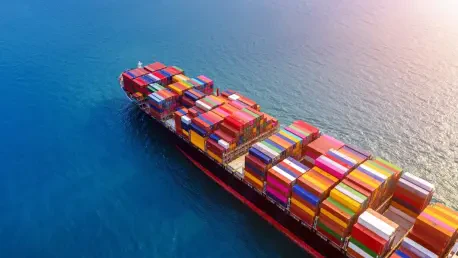Overview of the Global Shipping Industry
The global shipping industry, often regarded as the lifeblood of international trade, facilitates the movement of over 80% of the world’s merchandise, connecting markets and economies across continents with unmatched efficiency. This vast sector encompasses key segments such as container shipping, which handles consumer goods, and bulk carriers, responsible for transporting raw materials like coal and grain. Major players, including companies like Maersk and MSC, dominate the market, while the industry’s economic significance is undeniable, contributing billions to global GDP and supporting countless jobs.
Despite its critical role, the shipping sector is navigating turbulent waters in 2025, with trade volumes stagnating and operational challenges mounting. The industry underpins supply chains that sustain both developed and developing economies, yet it faces systemic issues that threaten its stability. From fluctuating demand to infrastructure bottlenecks, the current state reflects a complex web of economic and geopolitical pressures impacting its ability to function efficiently.
Current Trends and Market Dynamics
Slowing Trade Growth and Geopolitical Disruptions
Seaborne trade growth has decelerated sharply, with an estimated increase of just 0.5% this year, marking one of the slowest expansions in recent memory. This sluggish pace signals underlying weaknesses in global demand, compounded by uncertainties in major economies. The implications are far-reaching, as reduced trade volumes strain shipping companies already grappling with tight margins and overcapacity in some segments.
Geopolitical tensions further exacerbate the situation, particularly in strategic chokepoints like the Red Sea and Strait of Hormuz. Conflicts and instability in these regions have forced vessels to adopt longer, more expensive routes, driving up fuel consumption and transit times. As a result, freight rates have become highly volatile, creating unpredictability for shippers and disrupting the delicate balance of global logistics networks.
Market Impacts and Vulnerable Economies
Rising freight costs have hit vulnerable economies the hardest, with small island developing states and least developed countries bearing a disproportionate burden. Data indicates that shipping expenses for these nations have surged, directly inflating the cost of essential imports such as food and fuel. This trend threatens to widen economic disparities, as these regions lack the resources to absorb such financial shocks.
The ripple effects are particularly acute for net food-importing nations, where higher transportation costs translate into elevated food prices, exacerbating food insecurity. For communities already struggling with limited access to resources, this creates a vicious cycle of dependency and economic strain. The situation underscores the urgent need for targeted interventions to mitigate the impact on the most disadvantaged regions.
Operational and Technological Challenges
Port congestion remains a persistent hurdle, with extended waiting times at key hubs disrupting schedules and inflating costs for shipping lines. Many facilities lack the capacity to handle current cargo volumes, highlighting an urgent need for modernization. Digital tools, such as maritime single windows and integrated port systems, offer potential solutions by streamlining operations and reducing delays.
However, a significant digital divide persists, particularly in developing countries where access to advanced technology is limited. This gap hinders the adoption of efficiency-boosting innovations, leaving some regions at a competitive disadvantage. Moreover, the rise of cybersecurity threats adds another layer of complexity, as digitized systems become prime targets for attacks, necessitating robust defenses to protect critical infrastructure.
Addressing these challenges requires substantial investment in both physical and digital infrastructure. Governments and industry stakeholders must prioritize funding for port upgrades and technology adoption while fostering international cooperation to bridge the digital divide. Strategic planning and resource allocation will be key to building a more resilient and efficient maritime network capable of withstanding future disruptions.
Environmental Pressures and Regulatory Shifts
Greenhouse gas emissions from shipping have climbed by 5% over recent years, intensifying scrutiny on the industry’s environmental footprint. Despite growing awareness, only 8% of global fleet tonnage is equipped to use alternative fuels, indicating a sluggish transition toward sustainability. This lag poses a significant barrier to meeting international climate goals and curbing the sector’s contribution to global warming.
Regulatory momentum is building, with the International Maritime Organization set to deliberate on a Net-Zero Framework later this year. Discussions may lead to the introduction of a global fuel standard and carbon pricing mechanisms, aimed at incentivizing cleaner practices. Such measures, if adopted, could reshape operational norms and push companies to accelerate their shift to low-emission technologies.
Support for these initiatives comes from various quarters, with calls for clear regulations, fleet renewal, and investment in sustainable fuel infrastructure gaining traction. Emphasis is placed on ensuring that transitions are just, avoiding undue burden on smaller operators or developing nations. Balancing environmental imperatives with economic realities remains a central challenge for policymakers and industry leaders alike.
Human Rights and Social Challenges in Shipping
The human toll of the industry’s struggles is evident in the record levels of seafarer abandonment reported recently, with crews often left stranded without pay or adequate support. These incidents reflect systemic failures in protecting the welfare of maritime workers, who endure harsh conditions and prolonged isolation. The plight of these individuals highlights a critical area of concern amid broader economic pressures.
Amendments to the Maritime Labour Convention, slated for implementation by 2027, aim to strengthen protections, including rights to repatriation and shore leave. While these changes signal progress, enforcement remains a significant gap, with many violations going unaddressed due to jurisdictional complexities. Robust mechanisms are needed to ensure compliance and safeguard the dignity of seafarers.
Beyond legal frameworks, there is a pressing need for industry-wide accountability to address these social challenges. Collaborative efforts between governments, shipping companies, and international bodies can help establish stronger safety nets for workers. Prioritizing human rights in maritime operations is essential to mitigate the personal hardships caused by trade disruptions and economic uncertainty.
Future Outlook and Path Forward
Looking ahead, the shipping industry stands at a crossroads, with its trajectory hinging on coordinated action among governments, businesses, and international organizations. Stabilizing trade policies to reduce uncertainty will be crucial, as will investments in resilient infrastructure to handle fluctuating demand. The path forward demands a multifaceted approach that addresses both immediate pressures and long-term goals.
Emerging priorities include accelerating digitalization to enhance operational efficiency while bolstering cybersecurity to protect against evolving threats. Simultaneously, transitioning to cleaner fuels must be a focal point to align with global sustainability targets. Supporting vulnerable economies through targeted assistance will also be vital to ensure that the benefits of maritime trade are equitably distributed.
Building inclusive and resilient maritime systems is imperative amid ongoing global economic uncertainties. This involves fostering collaboration to tackle systemic issues like port inefficiencies and environmental impacts while safeguarding the interests of smaller nations. A collective commitment to innovation and equity can pave the way for a more stable and sustainable future for the industry.
Conclusion and Recommendations
Reflecting on the multifaceted crisis that has gripped the shipping sector, it became clear that economic slowdowns, geopolitical instability, environmental demands, and social challenges have converged to test the industry’s resilience. The analysis revealed deep vulnerabilities, particularly for disadvantaged regions, while highlighting the slow pace of technological and sustainable advancements. These findings underscored the complexity of navigating a global trade network under strain.
Moving forward, actionable steps emerged as critical to addressing the challenges unearthed during this period. Sustainable investments in port infrastructure and green technologies were identified as essential to reducing emissions and enhancing efficiency. Additionally, equitable transitions that prioritized support for developing nations offered a way to balance progress with fairness, ensuring no region was left behind.
Lastly, targeted recommendations included fostering international partnerships to close the digital divide and enforce labor protections for seafarers. Establishing clear regulatory frameworks for carbon pricing and fuel standards was also deemed necessary to drive environmental accountability. These measures, if implemented with urgency and collaboration, hold the potential to fortify the shipping industry against future uncertainties and sustain its role as a cornerstone of global commerce.









